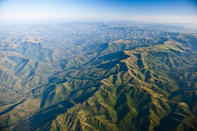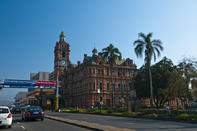Voortrekkers and Dingane
Late in 1837, numerous parties of Voortrekkers reached the Drakensberg, en route to the fertile land now known as KwaZulu-Natal. The leader of one group, Piet Retief, left his laager at the head of Oliviershoek Pass and set off with a delegation of 69 men, including his teenage son, to negotiate for land from the Zulu king, Dingane.

One of the king's conditions was that the trekkers first had to retrieve cattle stolen from Dingane by Tlokwa chief Sekonyela. This they did, arriving back at the royal kraal of uMgungundlovu on 3 February 1838, but their treatment of Sekonyela troubled Dingane and had made him deeply distrustful.
Formalities and festivities followed, however, and on the 6th a treaty was signed granting the trekkers the land between the uThukela and Mzimvubu Rivers (which later became Natal).
Little over a week later, the king organised a celebratory dance in the royal enclosure, instructing the Boers to leave their guns outside. As frenzied dancers pulsed in and out, the king suddenly gave orders to slay the 'white wizards'. The Boers were taken to the killing hill of KwaMatiwane where they were murdered.
Dingane was greatly disturbed by the arrival of armed white settlers in his realm. After the massacre of Retief's band, he sent out impis to locate and kill the various parties of trekkers laagered around Bloukrans hill and the Bushman's River Valley. When his warriors reached Bloukrans, they set upon the small wagon camps one by one.
All the next day the warriors kept locating and attacking Boer parties. In all, from 16 to 17 February 1838, 482 men, women and children - white trekkers and their servants of colour - were killed, and some 25 000 head of cattle taken. A monument was erected at Bloukrans in 1897 to commemorate the carnage.
Numerous Historic Treasures

Pietermaritzburg is a place of history: with more historical monuments housed here than anywhere else in South Africa, it owes its special character to its rich architectural heritage. Regarded as one of the finest Victorian cities in the world, Pietermaritzburg boasts with numerous historic treasures and monuments such as the Natal Museum, Msundi Museum Complex, City Hall and Comrades Marathon House.
An interesting monument is the statue of Mahatma Gandhi, situated on the spot where he was arrested for riding in a 'whites only' train carriage. He claimed that it was this moment that started his career of passive resistance.
The city’s natural heritage can be admired in Alexandra Park, Queen Elizabeth Park, Ferncliffe and Bisley Nature Reserve, as well as the Wylie Park with its views over the city and the Pietermaritzburg's Botanical Gardens.
The architecture of various buildings and hotels such as the Imperial Hotel further enhance the city's colonial feel. The Tatham Art Gallery has an extensive collection of South African art, as well as collections of 19th and 20th-century British and French painting.
Did You Know? Pietermaritzburg's City Hall was destroyed by a fire at the beginning of the last century. After it was rebuilt, it is said to be the largest red-brick building in the southern hemisphere, with the largest organ. Even if it isn’t, it is a particularly fine example of late Victorian architecture, complete with a Westminster-style clock tower that's 47 m high and houses 12 bells.